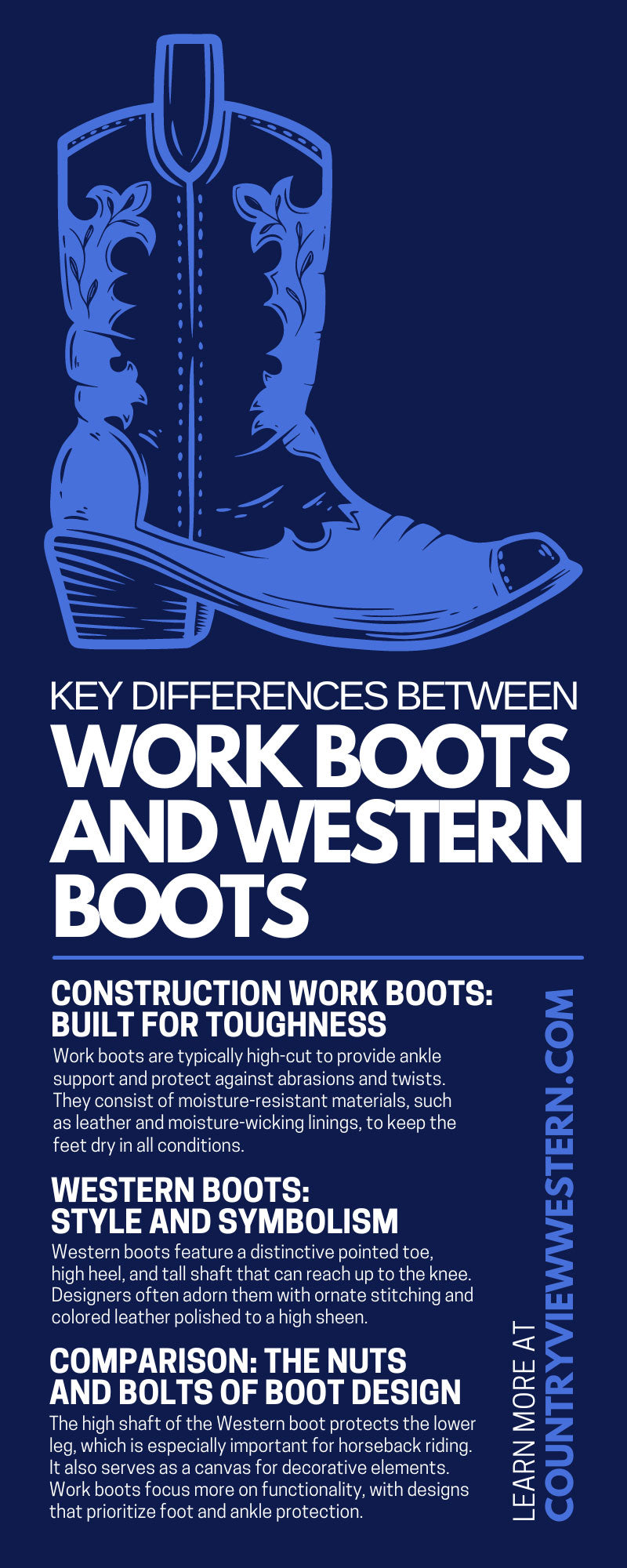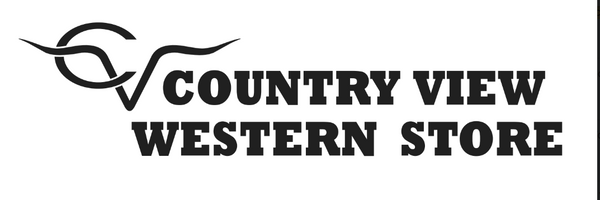Boots are more than just footwear. They are tools of the trade, fashion statements, and pieces of cultural history. Whether you’re a construction worker who relies on sturdy boots or someone who appreciates the legacy and style of Western wear, you should understand the uses and benefits of these different boots. We will explore the key differences between the rugged work boot, often worn by industrial workers, and the iconic Western boot, renowned for cowboy cool.
The Role of Boots in Our Lives
Boots are more than functional footwear. They often become synonymous with the wearer’s identity. Before we dissect these two boot types, let’s explore how they do so much more than protect the feet.
Historical Significance of Work and Western Boots
Work and Western boots evolved alongside movements in labor and culture. Work boots dug their heels in the US Industrial Revolution, when there was a dire need for footwear that could withstand the rigors of factory work, mining, and construction. Designers made them with safety and endurance in mind, incorporating features like steel toes and slip-resistant soles.
On the flip side, Western shoes emerged from the necessities of ranchers and cowherds who required sturdy boots to handle the tough conditions of the US frontier. With their distinctive high tops, pointed toes, and walking heels, Western boots became emblematic of the West and a symbol of rugged individualism.
Construction Work Boots: Built for Toughness
First, let’s take a look at the work boot. Manufacturers design them to withstand industrial job site conditions and protect wearers’ feet. They often feature heavy-duty steel toes, rubber soles, and puncture-resistant materials. Construction boots are ideal for performing jobs in hazardous environments.
Characteristics and Features
Work boots are typically high-cut to provide ankle support and protect against abrasions and twists. They consist of moisture-resistant materials, such as leather and moisture-wicking linings, to keep the feet dry in all conditions.
Safety First
Foot safety is the primary focus of work boots. They have steel toes, reinforced arches for ladder support, non-slip soles, and insulation against electrical hazards.
Durability Under Duress
Work boots can withstand the wear and tear of the job site, making them wise investments for anyone working in heavy industry.
Western Boots: Style and Symbolism
Western boots are a different breed altogether, balancing form and function for wear in less dangerous environments. Made for the ranch and the rodeo, these boots come in unique styles and reflect the spirit of the Wild West.
The Essence of Western Boots
Western boots feature a distinctive pointed toe, high heel, and tall shaft that can reach up to the knee. Designers often adorn them with ornate stitching and colored leather polished to a high sheen.
A Question of Comfort
While toughness is an essential characteristic of these boots, comfort is a secondary priority. Western boots may not offer the same level of protection as work boots, but they are comfortable to wear for hours thanks to their cushioned insoles, soft leather linings, and light, flexible materials.
Making a Statement
Aside from their practical applications, Western boots serve as a statement of personal style and cultural identity. From line dancing to casual wear, they’re beloved for their unique aesthetic and the stories they carry.
Comparison: The Nuts and Bolts of Boot Design
To understand the differences between these boots, it’s worth comparing their designs, materials, and purposes.
Material World
Work boots contain heavyweight leather and synthetic materials, emphasizing protection and durability. In contrast, Western boots have light leather and potentially exotic materials like snake or alligator skin for a fashionable flair.
Design and Function
The high shaft of the Western boot protects the lower leg, which is especially important for horseback riding. It also serves as a canvas for decorative elements. Work boots focus more on functionality, with designs that prioritize foot and ankle protection.
Purpose-Specific Features
Both boot types have unique features that cater to their intended use. For example, the tall, underslung heel of Western boots provides stability in the stirrups, while work boots often have a chunkier, flat tread to grip slippery surfaces.
Maintenance and Care: Prolonging the Boots’ Lifespan
Care and maintenance can significantly extend the lifespan of your boots, reflective of your investment in each pair.
Work Boot Regimen
Frequent cleaning to remove abrasive materials like gravel and chemicals is a must for work boots. Periodically conditioning the leather and ensuring seams are in good condition will help you maintain the boots’ waterproofing and structural integrity.
Western Boot Care
Western boots require a more delicate approach, given their ornate design. Polishing with leather conditioners and being mindful of heel and sole wear can keep them looking and feeling pristine.
Who Benefits From What?
It’s important to understand the benefits of each boot for different lifestyles and professions.
Catering to the Construction Crowd
If you work in the construction industry, durable work boots may be the difference between safety and serious injury. Their sturdy build and protective features make them indispensable personal protective equipment (PPE) on the job site.
Speaking to Western Enthusiasts
Western boots span a broad spectrum, and your affection for these boots is likely due to more than utility. It’s about connecting to a heritage, expressing individuality, and drawing inspiration from the frontier spirit linked to these iconic shoes.
The Boots That Define Us
Whether you’re lacing up for the daily grind on a construction site or sliding into a pair of Western boots for a night of two-stepping, the shoes you choose should support your lifestyle. Footwear serves as protection and a visual and cultural statement, so understanding the differences between work boots and western boots is the key to safety and style.
In the end, it’s not just the boot but rather the person wearing it that makes the difference. Each scuff and scrape tell a story of where you’ve been and what you’ve done. Your boots are with you every step of the way, from the dusty riding trails to the steel girders of the city skyline.


